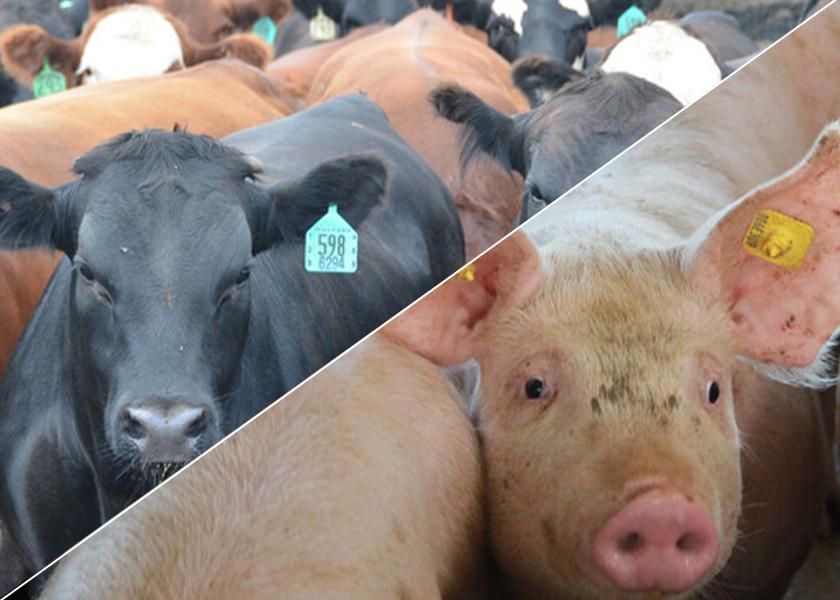Livestock Analysis | August 3, 2022

Price action: August lean hog futures rose $1.15 to $121.00, while October futures fell 37.5 cents to $95.85.
Fundamental analysis: August lean hogs resumed a five-week rally following Tuesday’s corrective selling, posting the highest settlement for a nearby contract since June 2021. By contrast, October futures leapt higher in the open but lost steam by late morning. August futures are trading at a premium to the cash index, implying firmness through the end of next week, with pessimistic discounts in the fall and winter contracts. The USDA’s national average hog price for Tuesday surged $5.19 to $121.33, while the CME lean hog index fell 30 cents to $121.57 (as of Aug. 1). Tomorrow’s quote is expected to fall another 63 cents to $120.94.
Wholesale prices eased but remain near a 14-month high. Pork cutout values fell $1.27 early today to $129.76, while USDA’s national pork carcass cutout value for Tuesday was $3.32 stronger at $131.02. Hog slaughter so far this week was an estimated 1.349 million head, down 36,000 head from the same period last week and down 6,000 head from a year ago.
Technical analysis: Bulls retained an advantage in nearby futures August contract, with a potential bullish pennant forming. October futures gained early but eroded by the close and settled below the 10-day moving average for the first time since July 26, indicating the possibility of consolidation near term. October futures held within a range above support levels at $95.375 and $94.525. Resistance lies at $97.075, and an additional close above the level could confirm an extended period of upside potential. The next area of note is at $97.925, a level not traded since mid-late April.
What to do: Be prepared to extend feed coverage when market bottoms are in place.
Hedgers: Carry all risk in the cash market for now.
Feed needs: You are hand-to-mouth on corn-for-feed and soybean meal needs.
Price action: August live cattle rose $1.325 to $137.90, while October jumped $1.825 to $143.95, a three-month closing high. September feeder futures rallied $1.45 to $182.90.
Fundamental analysis: Cattle futures surged behind signs this week’s cash trade will reverse a four-week slide. Meatpackers relied heavily upon contracted and previously purchased fed cattle supplies through much of July, which may have depleted the supplies they had available this month. That may explain their aggressive purchases Tuesday afternoon. For example, after having paid $136.88 for fed steers by Tuesday of last week, they paid an average of $139.82 yesterday. Moreover, with the supply of market-ready animals proving extremely tight, as indicated by the choice-select beef price spread around $27 today versus the 10-year average around $10.00, traders interpreted this week’s early cash surge as signaling more of the same during the weeks ahead. That’s best indicated by the comparatively large gains posted by the fourth-quarter contracts and the premiums they carry to the cash market.
Choice beef cutout values fell Tuesday after pushing above $270 last Friday but rose 29 cents to $268.75 at midsession today. We expect modest wholesale beef gains through mid-August as grocers build inventories for Labor Day features. Based on June retail prices, it appears demand won’t decline substantially this fall, reflecting historical patterns for meat demand to hold up well during recessions. This is predicated upon the idea that consumers eat out in restaurants much less during recessions but buy more product to be eaten at home.
Feeder futures also rose, but gains were muted considering the concurrent fed cattle strength and grain and soybean weakness. The sizeable premiums over the feeder index, now at $174.40, already built into the yearling contracts, may have limited futures gains.
Technical analysis: Today’s October live cattle advance puts bulls in a very strong technical position. The rise marked a breakout above the contract’s June and July highs and the close at $144.00 marked the contract’s highest since May 5. Bulls will be looking to fill the April 25 chart gap between $144.675 and $145.975, then target the contract high at $147.50. Initial support seems likely to emerge around the July 22 high of $143.20, then at the 10-day moving average near $142.50. A drop below that level would then have bears targeting the 20-day moving average near $141.45 and last week’s low at $141.425. A close below that area would open the door to a test of the 40-day moving average at $141.05.
Feeder futures bulls also hold a technical advantage, although September futures continue to hold the recent trading range. The high-range close made the 10-day moving average near $182.00 initial support, with strong backing from today’s low and the 20-day moving average near $180.925. A drop below that area would have bears targeting the 40-day moving average at $178.22. Yesterday’s high marks resistance at $183.85, with strong backing likely to emerge at the July high of $184.90. A breakout above that point would have bulls targeting the February 16 contract high at $188.25.
What to do: Be prepared to extend feed coverage when market bottoms are in place.
Hedgers: Carry all risk in the cash market for now.
Feed needs: You are hand-to-mouth on corn-for-feed and soybean meal needs.






